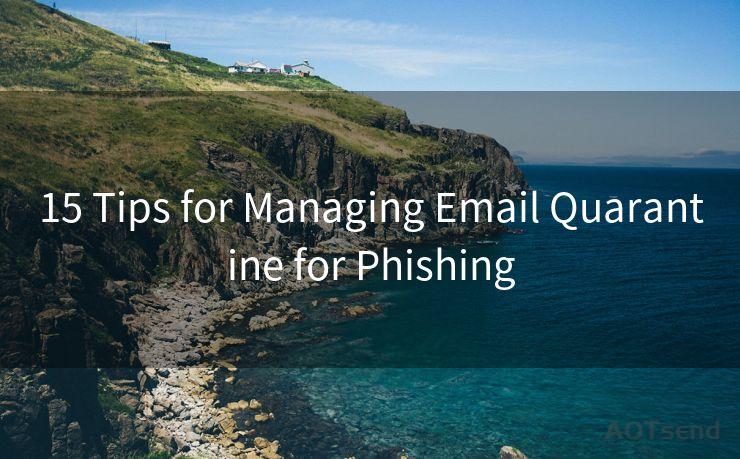15 Tips for Managing Email Quarantine for Phishing




Email quarantine is a crucial security measure to prevent phishing attacks. By isolating suspicious emails, organizations can significantly reduce the risk of malicious content infiltrating their networks. Here are 15 tips to help you effectively manage email quarantine and keep phishing attacks at bay.
1. Establish Clear Quarantine Policies
Having a clear and well-documented email quarantine policy is essential. This policy should outline the criteria for quarantining emails, the process for reviewing and releasing emails, and the responsibilities of the IT team.
2. Use Advanced Filtering Techniques
Employ advanced filtering techniques, such as heuristic analysis and sandboxing, to identify and isolate suspicious emails. These methods can detect patterns and behaviors associated with phishing attacks.

3. Regularly Update Filtering Rules
Phishing techniques evolve rapidly. Regularly updating your filtering rules ensures that your quarantine system can detect the latest threats.
4. Train Employees on Phishing Awareness
Employee education is key. Conduct regular phishing awareness training to teach employees how to recognize and report suspicious emails.
5. Implement Multi-Factor Authentication
Enhance email security by implementing multi-factor authentication. This adds an extra layer of protection, making it harder for attackers to gain access to email accounts.
6. Monitor Quarantined Emails Regularly
Regularly monitor the quarantined email folder to ensure no legitimate emails are mistakenly isolated. Have a process to promptly release any falsely quarantined messages.
7. Utilize Threat Intelligence Feeds
Integrate threat intelligence feeds into your email security solution. These feeds provide up-to-date information on known phishing threats, helping your system identify and quarantine them more effectively.
8. Enable DMARC, DKIM, and SPF
Implement DMARC (Domain-based Message Authentication, Reporting, and Conformance), DKIM (DomainKeys Identified Mail), and SPF (Sender Policy Framework) to authenticate incoming emails and reduce the risk of spoofing.
9. Conduct Periodic Security Audits
Perform periodic security audits to assess the effectiveness of your email quarantine measures. Use the findings to improve your security posture.
10. Leverage AI and Machine Learning
Utilize AI and machine learning technologies to enhance email filtering accuracy. These technologies can analyze email patterns and behaviors to identify phishing attempts more precisely.
11. Have a Response Plan for Quarantined Emails
Develop a clear response plan for handling quarantined emails. This plan should include steps for investigating, reporting, and responding to potential phishing attempts.
12. Encourage User Feedback
Encourage employees to provide feedback on quarantined emails. This feedback can help fine-tune your filtering rules and improve the accuracy of your quarantine system.
13. Maintain a Secure Email Gateway
Deploy a secure email gateway that incorporates advanced threat detection and quarantine capabilities. This adds another crucial layer of defense against phishing attacks.
14. Backup and Archive Emails
Regularly backup and archive emails to ensure data integrity. In case of a false positive quarantine, you can quickly restore important emails.
🔔🔔🔔
【AOTsend Email API】:AOTsend is a Managed Email Service for sending transactional emails. Support Email Types: reminders, authentication, confirmations, notifications, verification codes, invoices, password resets, account activations, billing statements, two-factor authentication (2FA), and one-time passwords (OTP) emails, etc. $0.28 per 1000 Emails. 99% Delivery, 98% Inbox Rate.
You might be interested in:
Why did we start the AOTsend project, Brand Story?
What is a Managed Email API, How it Works?
Best 25+ Email Marketing Platforms (Authority,Keywords&Traffic Comparison)
Best 24+ Email Marketing Service (Price, Pros&Cons Comparison)
Email APIs vs SMTP: How they Works, Any Difference?
15. Stay Updated on Phishing Trends
Keep yourself updated on the latest phishing trends and techniques. This knowledge helps you adjust your quarantine strategies to counter emerging threats effectively.
By following these 15 tips, you can significantly enhance your organization's email security and reduce the risk of phishing attacks. Remember, a proactive approach to email quarantine management is key to safeguarding your network from malicious intrusions.




Scan the QR code to access on your mobile device.
Copyright notice: This article is published by AotSend. Reproduction requires attribution.
Article Link:https://www.mailwot.com/p1850.html



